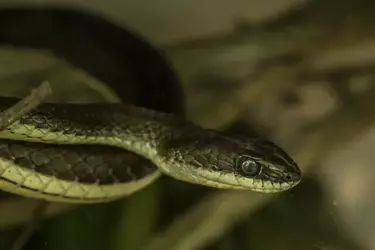
Tim Friede at home in Wisconsin with a snake. Peter Prato
By Apoorva Mandavilli
May 2, 2025 Updated 4:31 p.m. ET
The video is just under two and a half minutes long. A slim man with close-cropped hair walks into a room, pulls a long black mamba — whose venom can kill within an hour — from a crate and allows it to bite his left arm. Immediately after, he lets a taipan from Papua New Guinea bite his right arm. “Thanks for watching,” he calmly tells the camera, his left arm bleeding, and then exits.
Over nearly 18 years, the man, Tim Friede, 57, injected himself with more than 650 carefully calibrated, escalating doses of venom to build his immunity to 16 deadly snake species. He also allowed the snakes — mostly one at a time, but sometimes two, as in the video — to sink their sharp fangs into him about 200 times.
This bit of daredevilry (one name for it) may now help to solve a dire global health problem. More than 600 species of venomous snakes roam the earth, biting as many as 2.7 million people, killing about 120,000 people and maiming 400,000 others — numbers thought to be vast underestimates.
In Mr. Friede’s blood, scientists say they have identified antibodies that are capable of neutralizing the venom of multiple snake species, a step toward creating a universal antivenom, they reported on Friday in the journal Cell.
“I’m really proud that I can do something in life for humanity, to make a difference for people that are 8,000 miles away, that I’m never going to meet, never going to talk to, never going to see, probably,” said Mr. Friede, who lives in Two Rivers, Wis., where venomous snakes are not much of a threat.
While deforestation, human sprawl and climate change have heightened the danger from snake attacks in recent years, research on antivenom has not kept pace with demand.
“This is a bigger problem than the first world realizes,” said Jacob Glanville, founder and chief executive of Centivax, a company that aims to produce broad-spectrum vaccines, and lead author on the study.
Dr. Glanville and his colleagues found that two powerful antibodies from Mr. Freide’s blood, when combined with a drug that blocks neurotoxins, protected mice from the venom of 19 deadly snake species of a large family found in different geographical regions.
This is an extraordinary feat, according to experts not involved in the work. Most antivenoms can counter the venom from just one or a few related snake species from one region.
The study suggests that cocktails of antitoxins may successfully prevent deaths and injuries from all snake families, said Nicholas Casewell, a researcher at the Liverpool School of Tropical Medicine in England.
“The principles of this study can definitely be applied to other snakes,” he said.

Geoffrey Maranga and Fred Nyundo prepare to extract venom from a snake in Nairobi, Kenya.
In many parts of the world, encounters with snakes are commonplace and dangerous. Brian Otieno for The New York Times
Mr. Friede’s first snake encounter, a harmless bite by a garter snake at age 5, started a lifelong fascination. “If I only knew back then what was going to happen,” he recalled, laughing uproariously.
But he didn’t begin dabbling with snakes in earnest until he was married with children and working in construction. He began experimenting with scorpions around the year 2000, but quickly switched to snakes. At one point, his basement lab housed 60 venomous snakes.
His experiments nearly ended soon after they began. On Sept. 12, 2001, crazed by the terrorist attack of the previous day and by the death of a friend a few days earlier, he let himself be bitten by two cobras. They were his first bites by live snakes, and he had not built up enough immunity. He was fine after the first bite, but after the second, he felt cold, his eyes started to droop and he couldn’t talk. He blacked out and woke up from a coma in a hospital four days later.
His wife was furious, but he was angrier with himself. He vowed to become more methodical in his work, carefully measuring out doses of venom and timing his bites.
“I’d work all day, come home, play with the kids and the family, and go downstairs and do my stuff all night long, wake up and do it again,” he said.
There were other mishaps — accidental bites, anaphylactic shocks, hives, blackouts. Mr. Friede describes himself as a nondegree scientist, but “there’s no college in the world that can teach you how to do it,” he said. “I was doing it on my own as best I could.”
Two teams of scientists sampled Mr. Friede’s blood over the years, but neither project led anywhere. By the time he met Dr. Glanville, in 2017, he was nearly ready to give up.
Dr. Glanville had been pursuing what scientists call broadly acting antibodies as the basis for universal vaccines against viruses. He grew up in a Maya village in the Guatemala highlands, and became intrigued by the possibility of using the same approach for universal antivenom.
At first, he said, he had a “humble” goal of finding someone like a clumsy snake researcher who had been bitten a couple of times. But then he came across news articles about Mr. Friede.
“I’ve been waiting for this call for a long time,” Dr. Glanville recalls Mr. Friede as saying.

A snake at the Watamu Snake Farm in Kilifi County, Kenya. More than 600 species of venomous snakes roam the earth, biting as many as 2.7 million people, killing about 120,000 people and maiming 400,000 others — numbers thought to be vast underestimates. Brian Otieno for The New York Times
In collaboration with Peter Kwong, a vaccine researcher at Columbia University, Dr. Glanville isolated broadly acting antibodies from Mr. Friede’s blood and created the combination treatment.
The researchers tested antibodies from Mr. Friede’s blood against venom from 19 snake species. One broadly neutralizing antibody they identified protected mice from six of the species. Adding a small molecule called varespladib and a second antibody fully protected mice against 13 snake species, and provided a partial defense against the remaining six.
Cobras and mambas produce toxins that paralyze neurons. Venom from snakes in the viper family rips up tissues, causing victims to bleed to death. Each snake species within those families produces a distinct blend of dozens of toxins, and the venom even within a species can vary by region, age, diet and season.
But antivenom is made much the same way it was 130 years ago when it was first produced. A small amount of venom is pumped into a horse, camel or sheep, and the antibodies produced in response are harvested. The antibodies tend to be specific to the type of venom injected, and do little to ease symptoms from other types of snakes.
Many antivenoms, in fact, may pose more serious problems than venom itself, because the proteins from the mammal may trigger a deadly allergic shock.
Scientists are pursuing treatments that would avoid this side effect. Cocktails of small molecule drugs and monoclonal antibodies — artificially made copies of powerful human antibodies — against the most important toxin families may be able to neutralize the venom of many species, Dr. Casewell said.
The researchers next plan to test the treatment in Australia in any dogs that are brought into veterinary clinics for snakebites. They are also hoping to identify another component, perhaps also from Mr. Friede’s blood, that would extend full protection to all 19 snake species that were subjects of the research.
Mr. Friede himself is done now, however. His last bite was in November 2018, from a water cobra. He was divorced — his wife and children had moved out. “Well, that’s it, enough is enough,” he recalled thinking.
He misses the snakes, he said, but not the painful bites. “I’ll probably get back into it in the future,” he said. “But for right now, I’m happy where things are at.”
Source (Archive)
